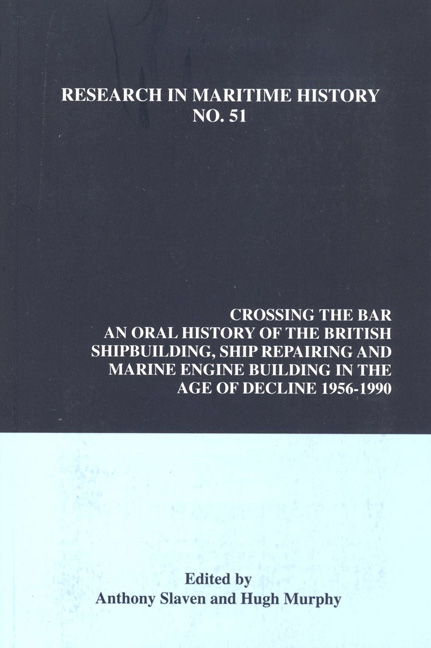 Crossing the Bar
Crossing the Bar from The Civil Servants, Board of Trade, Shipbuilding Enquiry Committee, Shipbuilding Industry Board, Ministry of Technology, Department of Trade and Industry, Department of Industry
I came in by an unlikely route. I had been in India having left for there on leaving Oxford. I was the Secretary of the Bombay Chamber of Commerce, and Secretary of the Metal Box Company in India. We were thinking of returning, when I saw the job advertised with the SIB. It is an important point that the SIB had been set up before I joined it. The secretary [Pat Hypher] was a Civil Servant and had been responsible for setting it up I knew because he had been the Trade Commissioner in Bombay. When the SIB was statutorily wound down my involvement with the industry ceased.
The man who did a lot of the leg work was Tony Hepper, particularly around the Upper Clyde. By the time I came onto the scene, the Civil Service had realised that the expectations that they had were not going to be realised. They understood that some chief executive was needed to make things happen rather than relying on shipbuilders to queue up and make submissions to the SIB. There was the usual sudden panic. We moved in about three to four weeks. It was the SIB which finally made the appointment.
One point needs to be stressed; there was no one on the SIB who knew anything about shipbuilding. It was not as daft as it sounded, because they could not have anybody from any of the yards, which were directly involved. I came in fully armed with the Geddes Report and that was about all. By the time I arrived they were about to sign the agreement on UCS. Tony Hepper had made all the running and he left the SIB just as I came in, to chair UCS. Right to the end, I think that the Shipbuilding Industry Act was actually rather good. It was good and it worked, because when the government was funding out grants and loans, it could only be done on the recommendations of the SIB. The Minister could only say yes or no. Of course we would liaise closely, but it did keep us apart from and at arms length from the department, which was very helpful. Given the nature of the Act, we were in a very strong position.
To save this book to your Kindle, first ensure [email protected] is added to your Approved Personal Document E-mail List under your Personal Document Settings on the Manage Your Content and Devices page of your Amazon account. Then enter the ‘name’ part of your Kindle email address below. Find out more about saving to your Kindle.
Note you can select to save to either the @free.kindle.com or @kindle.com variations. ‘@free.kindle.com’ emails are free but can only be saved to your device when it is connected to wi-fi. ‘@kindle.com’ emails can be delivered even when you are not connected to wi-fi, but note that service fees apply.
Find out more about the Kindle Personal Document Service.
To save content items to your account, please confirm that you agree to abide by our usage policies. If this is the first time you use this feature, you will be asked to authorise Cambridge Core to connect with your account. Find out more about saving content to Dropbox.
To save content items to your account, please confirm that you agree to abide by our usage policies. If this is the first time you use this feature, you will be asked to authorise Cambridge Core to connect with your account. Find out more about saving content to Google Drive.